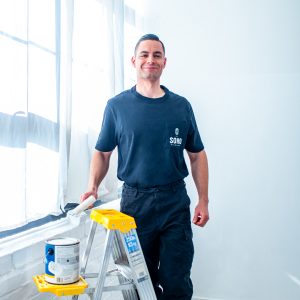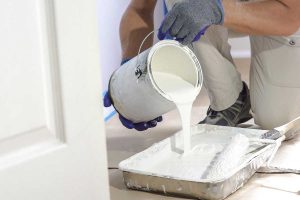Semi-gloss paint can easily transform a room from drab to fab with its glossy finish and versatility. But if an eggshell finish suits your style better, we won’t blame you if you want to cover up the old paint. Considering the high sheen and slick surface of semi-gloss, can you directly paint eggshell over it?
You’ll no longer have to wonder because we’ll discuss the differences between each paint formula to help you understand why painting over semi-gloss without prep work isn’t the best idea. As a bonus, we’ll also drop some tips on how to cover up a semi-gloss with eggshell flawlessly below.
What is semi-gloss paint?
Semi-gloss paint has a significant sheen where light bounces off its surface. Although it has a sleek finish, it’s more toned down than high-gloss paint.
One of the advantages of using semi-gloss paint is its durability because it’s less susceptible to moisture penetrating through the surface because its gloss creates a protective barrier. This also makes cleaning its surface effortless since you can wipe away grease, dirt, or stains with a damp cloth.
You can use this in humid and high-traffic rooms, such as the bathroom, laundry, kitchen, and living room. But because it reflects light easily, semi-gloss paint can also highlight the imperfections on your walls. So if you want to use this paint throughout your house, you must prep your walls beforehand by repairing any scuffs, cracks, or holes to ensure a smooth finish.
What is eggshell paint?
True to its name, eggshell paint has a duller glossy sheen than semi-gloss, but it’s not as flat as matte paint. It’s a popular choice for interior walls because it’s a good compromise for adding depth to any room without getting overwhelmed by its shiny finish.
Since eggshell has a subtle luster, it’s best to use in medium or low-traffic rooms, such as your bedrooms, study, or hallways. Since it doesn’t reflect as much light as semi-gloss paint, it can also easily conceal any imperfections on its surface.
But a downside to using eggshell paint on your walls is that it’s less durable than a semi-gloss formula because it doesn’t form the same tight seal against moisture.
Can you apply eggshell directly over semi-gloss?
Although it has several advantages, the high sheen of semi-gloss paint isn’t for everyone. So if you’re thinking of changing it, can you directly paint eggshell over its surface?
Technically, you can, but the eggshell paint won’t last as long since the slick surface of semi-gloss paint will stop it from fully adhering to the surface. That’s why it’s recommended to sand the old semi-gloss paint to reduce its sheen and remove it from the walls.
After sanding, applying 1-2 coats of primer is also a good idea since this will even out the surface and ensure the eggshell paint sticks better.
You should also consider whether the semi-gloss paint is oil or water-based so that you can apply the same formula for your eggshell paint. This is essential since mixing water and oil-based paints will result in flaking and chipping.
You can determine which formula is the semi-gloss by rubbing a cloth or towel doused with rubbing alcohol on an inconspicuous spot on your wall. If the paint rubs off onto the cloth, it’s water-based, while it’s oil-based if it doesn’t.
How to paint over semi-gloss paint
If you’re ready to get rid of the old semi-gloss paint on your walls, follow these steps below:
- Use sandpaper to remove the semi-gloss paint from the walls. You can start with a 120-grit sandpaper and adjust to a higher one if you need a rougher surface.
- Once done, use a damp rag to remove dust from sanding the paint.
- Repair any holes and cracks on the surface with joint compound or spackling to ensure a smooth finish and allow the patches to dry completely.
- If there are rough textures on your patched areas, give them a light sand to smoothen them out. Don’t forget to wipe away the dust with a damp cloth.
- Apply 1-2 coats of primer to provide an even surface for your paint.
- Once the primer is dry, apply 1-2 coats of your eggshell paint, making sure to let each coat dry completely before layering on the next one.
Can I paint over semi-gloss without sanding?
If you don’t have time to sand the semi-gloss paint from your walls, you can use Trisodium Phosphate (TSP) to prep the walls before painting. It’s a potent chemical traditionally used to clean surfaces and remove tough stains in preparation for painting. In this case, it removes the glossy sheen of semi-gloss, so it’s easier to apply primer and eggshell paint.
Note that TSP can pose risks to your health and the environment, so wear safety gear, such as goggles, mask, and gloves when working with it. Also, make sure you have proper ventilation in the area.
If you want to do this method, mix ¼ cup of TSP with 2 gallons of warm water until completely dissolved. Use a sponge to apply it on your wall with circular motions. Then, rinse the walls with clean and cool water to prevent residues from appearing. Let the surface dry completely before applying primer and eggshell paint.
Do I need an undercoat for eggshell paint?
If you’re unfamiliar, an undercoat is applied after primer to provide a smooth surface and neutral base for transitioning between colors. You don’t necessarily need to use an undercoat before applying eggshell because its sheen already does a decent job of concealing any imperfections on your walls.
If you want to transition from a dark or bright color to a neutral one, a primer with good coverage should be enough to prevent the old color from peeking through. But if you like, there’s no harm in applying a layer of undercoat for good measure.
Need help with painting your house?
If you need help transforming your walls from semi-gloss to an eggshell finish, Soho Painters can help. They have a team of experienced painters equipped with the best materials and training to ensure you get professional results. They also offer exterior, apartment, and commercial painting services to cover all your painting needs. For questions or inquiries, contact their team now and book a free estimate.





